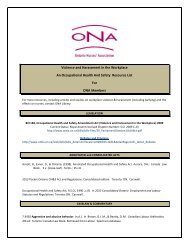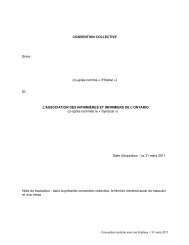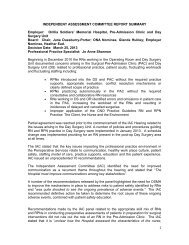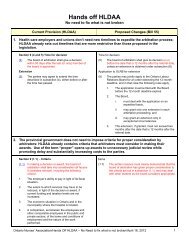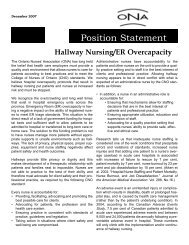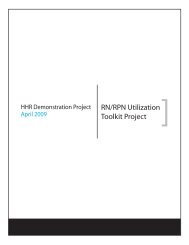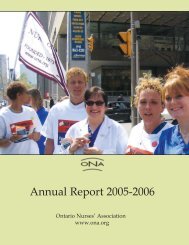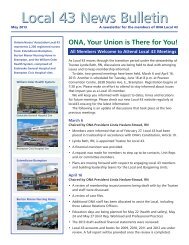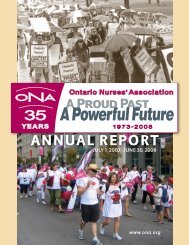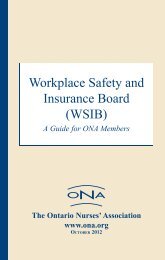RN and RPN Environment Professional Practice Teleconnect
RN and RPN Environment Professional Practice Teleconnect
RN and RPN Environment Professional Practice Teleconnect
You also want an ePaper? Increase the reach of your titles
YUMPU automatically turns print PDFs into web optimized ePapers that Google loves.
14<br />
<strong>Practice</strong> Guideline<br />
Glossary<br />
Application of knowledge. The use of knowledge<br />
in practice. It includes assessment, planning,<br />
implementation, evaluation of outcomes <strong>and</strong><br />
application of research. Application of knowledge<br />
encompasses decision-making <strong>and</strong> leadership.<br />
Autonomous practice. The ability to carry out<br />
nursing responsibilities independently.<br />
Client. The client is the person or persons with<br />
whom the nurse is engaged in a professional<br />
therapeutic relationship. The client may include<br />
family members of <strong>and</strong>/or substitute decisionmakers<br />
for the individual client. The client may also<br />
be a family, group, community or population.<br />
Collaboration. Working together with one or more<br />
members of the health care team, each of whom<br />
makes a unique contribution toward achieving a<br />
common goal. Collaboration is an ongoing process<br />
that requires effective communication between<br />
the members of the health care team <strong>and</strong> a clear<br />
underst<strong>and</strong>ing of the roles of the individuals<br />
involved in the collaboration process. Nurses<br />
collaborate with clients, other nurses <strong>and</strong> other<br />
members of the health care team in the interest of<br />
client care.<br />
Community. A group of people living in one place,<br />
neighbourhood or district, or sharing common<br />
characteristics or interests, or having common<br />
health needs. Nursing practice aimed at the<br />
community involves helping communities identify,<br />
articulate <strong>and</strong> successfully manage their health<br />
concerns. It is concerned primarily with care that is<br />
continuing, rather than episodic. When client care<br />
is mentioned in the context of the community, it<br />
does not mean providing care to an individual in<br />
the community –– the focus is on the collective or<br />
common good, instead of on an individual’s health.<br />
Competence. A nurse’s ability to integrate the<br />
professional attributes required to perform in a<br />
given role, situation or practice setting. <strong>Professional</strong><br />
attributes include, but are not limited to, knowledge,<br />
skill, judgment, attitudes, values <strong>and</strong> beliefs.<br />
Competencies. Statements describing the expected<br />
performance or behaviour that reflects the<br />
professional attributes required in a given nursing<br />
role, situation or practice setting.<br />
Decision-making. The ability to draw on many<br />
modes of thinking in order to select a course of<br />
action. It involves underst<strong>and</strong>ing <strong>and</strong> anticipating<br />
risks, benefits <strong>and</strong> outcomes beyond what is<br />
obvious, <strong>and</strong> creating a proactive plan of action<br />
based on this analysis. Critical thinking is an<br />
important component of effective decision-making.<br />
Group. People who interact <strong>and</strong> share a common<br />
purpose(s). There is no clear distinction between<br />
a group <strong>and</strong> a community except that groups tend<br />
to have fewer members than communities. The<br />
methods used to plan <strong>and</strong> provide programs or<br />
activities for groups <strong>and</strong> communities are similar<br />
except for scale.<br />
Health care team. An interprofessional group of<br />
individuals who are either directly or indirectly<br />
involved in a client’s care. Depending on the<br />
practice environment, the composition of the team<br />
will vary. The team includes the client <strong>and</strong> the<br />
family.<br />
Interprofessional care. The provision of<br />
comprehensive health services to clients by multiple<br />
health caregivers who work collaboratively to deliver<br />
quality care within <strong>and</strong> across settings.<br />
Intraprofessional care. The provision of<br />
comprehensive health care services to clients by<br />
multiple members of the same profession who work<br />
collaboratively to deliver quality care within <strong>and</strong><br />
across settings.<br />
Leadership. In nursing, leadership includes the<br />
ability to facilitate client groups, develop plans<br />
of care, teach others, work in teams, lead teams,<br />
influence the work environment <strong>and</strong> advocate for or<br />
bring about change. All nurses have the opportunity<br />
to develop leadership skills throughout their career.<br />
College of Nurses of Ontario <strong>Practice</strong> Guideline: <strong>RN</strong> <strong>and</strong> <strong>RPN</strong> practice: The Client, the Nurse <strong>and</strong> the <strong>Environment</strong>



